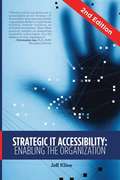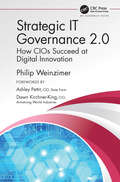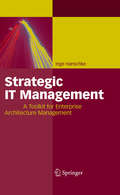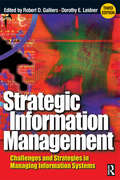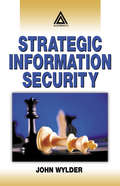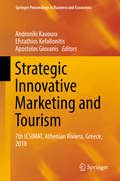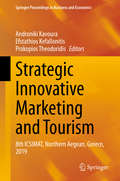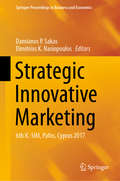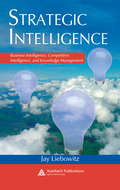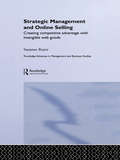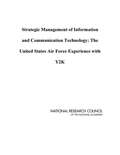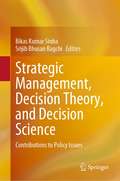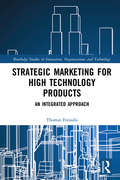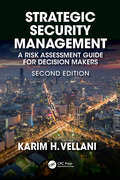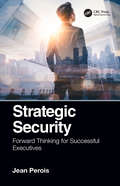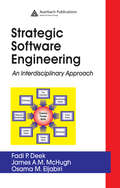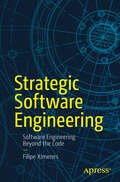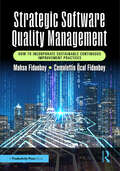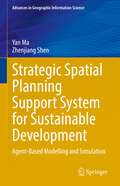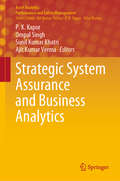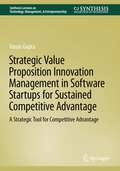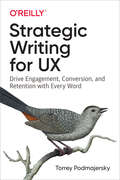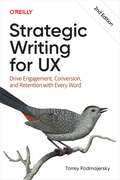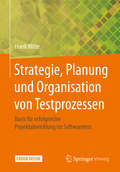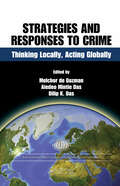- Table View
- List View
Strategic IT Accessibility: Enabling the Organization
by Jeff KlineThis strategic guide to understanding, enabling, and implementing information technology accessibility across organizations of any size, type, or geographic location, is an essential resource for technology professionals and executives. IT accessibility, or the lack thereof, can have a profoundly positive or negative effect on an organization in the private or public sector. Only when IT accessibility is considered organization-wide can one gain an appreciation for its potential advantages. Drawing on his decades of experience in IT accessibility leadership at IBM and in state government, Jeff Kline clearly articulates how to build and maintain holistic organization-wide IT accessibility programs that integrates IT accessibility into the fabric of your organization’s business, operations, and culture; make your organization’s IT offerings and internal IT environments accessible and inclusive to all audiences.
Strategic IT Governance 2.0: How CIOs Succeed at Digital Innovation
by Philip WeinzimerWeinzimer provides industry case studies of companies that have implemented multiple components of The Strategic IT Governance 2.0 model. These companies successfully leveraged collaboration between technology and the business to deliver technology projects that provide the best customer value, improve cost efficiencies, and create a governance culture across business areas. In his book, you will learn valuable lessons to implement an innovative governance model for your company.— Ashley Pettit, CIO, and Senior Vice President, Enterprise Technology, State Farm In Strategic IT Governance 2.0, Phil provides a number of exciting case studies of how CIOs are leveraging technology to innovate and create value. They are following Phil's model, building strategic and tactical relationships within the business to drive technology growth strategies, collaborating with partners to improve customer service and increase value with process optimization and best practice metrics. Each of these companies offers a slightly different take on the multiple components of the Strategic IT Governance 2.0 model; however, these organizations' collective and individual success indicates the strength of the components.— Dawn Kirchner-King, Vice President and Chief Information Officer, Armstrong World Industries Today's business environment is more complicated, creating additional challenges for the successful execution of strategic enterprise projects. Unless an organization revisits its governance model, strategic projects are at risk of negatively impacting business success. So, how do companies succeed in overcoming these obstacles to improve project success? Strategic IT Governance 2.0: How CIOs Succeed at Digital Innovation explains how IT executives can take the lead and successfully drive digital transformation initiatives and associated projects. The book presents the Strategic IT Governance 2.0 model that focuses on project alignment, process reinvention, and leadership excellence. It is filled with case studies of the model’s implementation, giving practical insight into how organizations have successfully executed digital transformation.
Strategic IT Management
by Inge HanschkeFor you as an IT manager, changes in business models and fast-paced innovation and product lifecycles pose a big challenge: you are required to anticipate the impact of future changes, and to make rapid decisions backed up by solid facts. To be successful you need an overall perspective of how business and IT interact. What you need is a toolkit, enabling you to manage the enterprise from a helicopter viewpoint while at the same time accommodating quite detailed aspects of processes, organization, and software lifecycles. Strategic IT management embraces all the processes required to analyze and document an enterprise's IT landscape. Based on the experience of many projects and long discussions with both customers and academic researchers, Inge Hanschke provides you with a comprehensive and practical toolkit for the strategic management of your IT landscape. She takes a holistic view on the management process and gives guidelines on how to establish, roll out, and maintain an enterprise IT landscape effectively. She shows you how to do it right first time - because often enough there's no second chance. She tells you how to tidy up a IT patchworks - the first step towards strategic management - and she gives you advice on how to implement changes and maintain the landscape over time. The book's structure reflects the patterns that exist in strategic IT management from strategic planning to actual implementation. The presentation uses many checklists, guidelines, and illustrations, which will help you to immediately apply the content. So, if you are a CIO, an IT manager, a business manager, or an IT consultant, this is the book from which you'll benefit in most daily work situations.
Strategic Information Management: Challenges And Strategies In Managing Information Systems (Management Reader Ser.)
by Robert D. Galliers Dorothy E Leidner'Strategic Information Management' has been completely up-dated to reflect the rapid changes in IT and the business environment since the publication of the second edition. Half of the readings in the book have been replaced to address current issues and the latest thinking in Information Management. It goes without saying that Information technology has had a major impact on individuals, organizations and society over the past 50 years or so. There are few organizations that can afford to ignore IT and few individuals who would prefer to be without it. As managerial tasks become more complex, so the nature of the requiredinformation systems (IS) changes - from structured, routine support to ad hoc, unstructured, complex enquiries at the highest levels of management.As with the first and second editions, this third edition of 'Strategic Information Management: Challenges and strategies in managing informationsystems' aims to present the many complex and inter-related issues associated with the management of information systems. The book provides a rich source of material reflecting recent thinking on the key issues facing executives in information systems management. It draws from a wide range of contemporary articles written by leading experts from North America and Europe.'Strategic Information Management' is designed as a course text for MBA, Master's level students and senior undergraduate students taking courses in information management. It provides a wealth of information and references for researchers in addition.
Strategic Information Security
by John WylderThe new emphasis on physical security resulting from the terrorist threat has forced many information security professionals to struggle to maintain their organization's focus on protecting information assets. In order to command attention, they need to emphasize the broader role of information security in the strategy of their companies. Until now
Strategic Innovative Marketing and Tourism: 7th ICSIMAT, Athenian Riviera, Greece, 2018 (Springer Proceedings in Business and Economics)
by Androniki Kavoura Efstathios Kefallonitis Apostolos GiovanisThis book covers a very broad range of topics in marketing, communication, and tourism, focusing especially on new perspectives and technologies that promise to influence the future direction of marketing research and practice in a digital and innovational era. Among the areas covered are product and brand management, strategic marketing, B2B marketing and sales management, international marketing, business communication and advertising, digital and social marketing, tourism and hospitality marketing and management, destination branding and cultural management, and event marketing. The book comprises the proceedings of the International Conference on Strategic Innovative Marketing and Tourism (ICSIMAT) 2018, where researchers, academics, and government and industry practitioners from around the world came together to discuss best practices, the latest research, new paradigms, and advances in theory. It will be of interest to a wide audience, including members of the academic community, MSc and PhD students, and marketing and tourism professionals.
Strategic Innovative Marketing and Tourism: 8th ICSIMAT, Northern Aegean, Greece, 2019 (Springer Proceedings in Business and Economics)
by Androniki Kavoura Efstathios Kefallonitis Prokopios TheodoridisThis book covers a very broad range of topics in marketing, communication, and tourism, focusing especially on new perspectives and technologies that promise to influence the future direction of marketing research and practice in a digital and innovational era. Among the areas covered are product and brand management, strategic marketing, B2B marketing and sales management, international marketing, business communication and advertising, digital and social marketing, tourism and hospitality marketing and management, destination branding and cultural management, and event marketing. The book comprises the proceedings of the International Conference on Strategic Innovative Marketing and Tourism (ICSIMAT) 2019, where researchers, academics, and government and industry practitioners from around the world came together to discuss best practices, the latest research, new paradigms, and advances in theory. It will be of interest to a wide audience, including members of the academic community, MSc and PhD students, and marketing and tourism professionals.
Strategic Innovative Marketing: 6th IC-SIM, Pafos, Cyprus 2017 (Springer Proceedings in Business and Economics)
by Damianos P. Sakas Dimitrios K. NasiopoulosThis proceedings volume highlights cutting-edge approaches for contemporary issues evolved in strategic marketing and the integration of theory and practice. It focuses on strategic research and innovative activities in marketing that can be used in everyday operations. The contributions have been divided into eight sections, grouping emerging marketing technologies together in a close examination of practices, problems and trends. The first section examines management challenges which influence societies, cultures, networks, organizations, teams, and individuals. It emphasizes ways business processes foster innovation and facilitate management transitions from dominant structures to more evolutionary, developmental paradigms. The second section discusses the benefits and guidelines to implementation of green marketing strategies. The following section pursues new perspectives of the role of location in marketing and its impact on consumer well-being. The next section explores the impacts of user generated content (UGC) on marketing theories and practice, which is followed by a section identifying how market-based assets can contribute to a sustainable competitive advantage. The sixth section covers understanding consumer perception to make marketing decisions. The final sections promote the use of business informatics and modeling in marketing and also the development of integrating information management in ways that change how people use information to engage in knowledge focused activities. The papers from the proceedings of the 6th International Conference on Strategic Innovative Marketing (IC-SIM 2017) have been written by scientists, researchers, practitioners and students that demonstrate a special orientation in strategic marketing, all of whom aspire to be ahead of the curve based on the pillars of innovation. This proceedings volume shares their recent contributions to the field and showcases their exchange of insights on strategic issues in the science of innovation marketing.
Strategic Intelligence: Business Intelligence, Competitive Intelligence, and Knowledge Management
by Jay LiebowitzStrategic intelligence (SI) has mostly been used in military settings, but its worth goes well beyond that limited role. It has become invaluable for improving any organization's strategic decision making process. The author of Strategic Intelligence: Business Intelligence, Competitive Intelligence, and Knowledge Management recognizes synergies amo
Strategic Management and Online Selling: Creating Competitive Advantage with Intangible Web Goods (Routledge Advances in Management and Business Studies #Vol. 29)
by Susanne RoyerFocusing on Business to Customer (B2C) internet business, and on firms that offer intangible products and/or services that can be directly consumed via the world wide web, Strategic Management and Online Selling also covers immaterial products and online news information or home banking. Considering how firms with similar specific characteristics are able to realize competitive advantages, this topical book discusses an area of particular contemporary importance and increasing academic study.
Strategic Management of Information and Communication Technology: The United States Air Force Experience with Y2K
by National Research Council of the National AcademiesAlthough Y2K did not result in major disruptions, the event is a rich source of critical lessons for strategic management of information and communication technology (ICT), many of which apply to large organizations today. Using a case study approach, this report describes lessons learned from the response of the Air Force to Y2K and makes recommendations for managing ICT complexity, aligning organizational and ICT strategies, and minimizing risk.
Strategic Management, Decision Theory, and Decision Science: Contributions to Policy Issues
by Bikas Kumar Sinha Srijib Bhusan BagchiThis book contains international perspectives that unifies the themes of strategic management, decision theory, and data science. It contains thought-provoking presentations of case studies backed by adequate analysis adding significance to the discussions. Most of the decision-making models in use do take due advantage of collection and processing of relevant data using appropriate analytics oriented to provide inputs into effective decision-making. The book showcases applications in diverse fields including banking and insurance, portfolio management, inventory analysis, performance assessment of comparable economic agents, managing utilities in a health-care facility, reducing traffic snarls on highways, monitoring achievement of some of the sustainable development goals in a country or state, and similar other areas that showcase policy implications. It holds immense value for researchers as well as professionals responsible for organizational decisions.
Strategic Marketing for High Technology Products: An Integrated Approach (Routledge Studies in Innovation, Organizations and Technology)
by Thomas FotiadisIn order for High Technology (HT) companies to tackle contemporary demanding market challenges, they frequently deploy time-reduction strategies with respect to product launch. Marketing of technology related products – and especially cutting edge ones – involves a complex and multidimensional bundle of specific and unique characteristics, such as the complexity of products, the intensity of the competition, confusion and/ or fear of adoption among consumers, fast pacing changes in the external environment. The very nature of the interrelations that evolve as part of the dynamic process of strategy formulation contributes further to the formulation of a very challenging environment which is described as tumultuous, volatile and turbulent. These specific features, qualities and characteristics constitute the core of the innate need for an integrated approach that requires and depends on the cooperation and coordination of specific functional competencies. This book employs a systemic approach that accommodates the integration of specialized departmental capabilities as a fundamental prerequisite and a cornerstone for the successful navigation of high-tech organizations in their extremely competitive environments. It provides a solid and extant context of compact and consistent cognitive background that is specific to the HT strategic marketing field, and a strategic tool that utilizes, relies and is built on the turbulent environment of HT rather than just overlooking, avoiding or ignoring it, and that assumes a proactive point of view, capitalizing on characteristics specific to this field, through the provision of a strategic managerial and marketing model that is overlaid onto a reliably assessed foundation of dynamic qualities, with a long-term orientation and scope, albeit one that would be easy to apply and which will generate immediate results.
Strategic Security Management: A Risk Assessment Guide for Decision Makers, Second Edition
by Karim VellaniStrategic Security Management, Second Edition provides security leadership and decision-makers with a fresh perspective on threat, vulnerability, and risk assessment. The book offers a framework to look at applying security analysis and theory into practice for effective security program, implementation, management and evaluation. Chapters examine metric-based security resource allocation of countermeasures, including security procedures, utilization of personnel, and electronic measures. The new edition is fully updated to reflect the latest industry best-practices and includes contributions from security industry leaders—based on their years of professional experience—including: Nick Vellani, Michael Silva, Kenneth Wheatley, Robert Emery, Michael Haggard. Strategic Security Management, Second Edition will be a welcome addition to the security literature for all security professionals, security managers, and criminal justice students interested in understanding foundational security principles and their application.
Strategic Security: Forward Thinking for Successful Executives
by Jean PeroisStrategic Security will help security managers, and those aspiring to the position, to think strategically about their job, the culture of their workplace, and the nature of security planning and implementation. Security professionals tend to focus on the immediate (the urgent) rather than the important and essential—too often serving as "firefighters" rather than strategists. This book will help professionals consider their roles, and structure their tasks through a strategic approach without neglecting their career objectives. Few security management books for professionals in the field focus on corporate or industrial security from a strategic perspective. Books on the market normally provide "recipes," methods or guidelines to develop, plans, policies or procedures. However, many do so without taking into account the personal element that is supposed to apply these methods. In this book, the authors helps readers to consider their own career development in parallel with establishing their organisation security programme. This is fundamental to becoming, and serving as, a quality, effective manager. The element of considering career objectives as part-and-parcel to this is both unique to only this book and vital for long-term career success. The author delineates what makes strategic thinking different in a corporate and security environment. While strategy is crucial in the running of a company, the traditional attitude towards security is that it has to fix issues quickly and at low cost. This is an attitude that no other department would tolerate, but because of its image, security departments sometimes have major issues with buy-in and from top-management. The book covers the necessary level of strategic thinking to put their ideas into practice. Once this is achieved, the strategic process is explained, including the need to build the different steps into this process—and into the overarching business goals of the organisation—will be demonstrated. The book provides numerous hand-on examples of how to formulate and execute the strategic master plan for the organization. The authors draws on his extensive experience and successes to serve as a valuable resource to all security professionals looking to advance their careers in the field.
Strategic Software Engineering: An Interdisciplinary Approach
by Fadi P. Deek James A. McHugh Osama M. EljabiriThe pervasiveness of software in business makes it crucial that software engineers and developers understand how software development impacts an entire organization. Strategic Software Engineering: An Interdisciplinary Approach presents software engineering as a strategic, business-oriented, interdisciplinary endeavor, rather than simply a technica
Strategic Software Engineering: Software Engineering Beyond the Code
by Filipe XimenesThe role of a software engineer goes well beyond writing code. In many companies, large or small, engineers often need to understand unfamiliar business rules, and then coordinate with multiple groups to ship software within a tight schedule. Although the skills required to perform this job effectively can be hidden within one's years of experience, learning from mistakes, peer guidance, and available resources, are critical to success. This book summarizes the skills and practices effective engineers should leverage to excel at their job. A chapter is dedicated to each of the four main pillars that form a successful engineering career: Self-Management, Technical Discipline, Risk Management, and Strategic Teamwork. Topics covered within each pillar include insights and tips on how to enhance your career simply by making small changes in the way you work. Based on a collection of mentorship sessions from author Filipe Ximenes, Strategic Software Engineering will empower you to maximize the impact of your work. What You Will Learn Master skills beyond writing code to achieve career goals. Make your day-to day work more impactful through meaningful changes. Identify, mitigate, and manage risk. Leverage teamwork and collaboration to build successful products. Who This Book Is For Mid-level engineers looking to make the jump to senior roles, as well as experienced engineers and managers who are looking to bolster their careers
Strategic Software Quality Management: How to Incorporate Sustainable Continuous Improvement Practices
by Mahsa Fidanboy Cemalettin Öcal FidanboyThis book introduces strategic management tools and techniques appropriate for use in software quality management. There has been a gap between strategic management and software quality, and the solutions for solving the problems and improving the software quality usually come from the experience of IT experts: the managerial experience. This book helps people interested in software quality to go beyond the IT technical issues and integrate strategic management tools with their technical knowledge to become more prepared for the future, develop long-term plans for solutions and improvements, take more strategic decisions even when compared with the competitors, and finally, reach sustainable continuous improvements.This book, by bridging software quality management and strategic management, can be used by software quality practitioners for effective results. The software development process is usually studied with regards to its functional aspects and the attempts to improve the quality and performance are mainly concentrated on the technical side. The developers, testers, or engineers search for solutions mostly directed toward a local problem specific to a unit, department, or code. What is often missing is grasping the big image of the problem: the managerial aspect. Even if all the technical staff are doing their tasks as they were planned, there is a vital need for identifying the bottlenecks and the points in need of improvements, alterations, and exclusions, together with tracking the progress and coming up with future strategies. This makes the software quality management activities intertwined with the strategic management concepts where strategic management enhances the quality management with its tools and techniques, and, in return, the software quality management provides the strategic management with insights on the technical issues, resulting in symbiosis. The highly competitive nature of the IT world makes it inevitable to take strategic tools and techniques into account and infuse them into the technical practices of software quality management.This book encompasses the following chapters: analyzing the current situation, identifying the improvement areas, determining the strategies, tracking the progress, and achieving a sustainable improvement.
Strategic Spatial Planning Support System for Sustainable Development: Agent-Based Modelling and Simulation (Advances in Geographic Information Science)
by Zhenjiang Shen Yan MaThis book introduces a planning support system called Strategic Spatial Plan Support System (SSP-SS) to visualize population growth and predict energy demand, land use, and waste discharge resulting from urbanization. By analyzing policy interactions between household agents, the book uses SSP-SS to visualize policy effects on urban areas during stages of growth and decline. Simulations are created based on these policy outcome assessments, taking into account the influences of energy and resource consumption on sustainable development in urban environments. The book is geared towards researchers, universities, and urban policy makers.The book begins by presenting a framework of urban growth simulation, and introducing SSP-SS. Then, household lifecycle and relocation models are employed for simulating policy impacts on urbanization, and investigating the impacts of spatial strategic planning. Several projects are assessed using agent-based modeling including shopping centre construction, day-care service for aging populations, and shelter accommodation capacities for earthquakes and other disasters. The final chapters discuss water and energy management, the environmental impacts of demand and consumption, and future recommendations for sustainable development and policy implementation.Introduces Strategic Spatial Plan Support System (SSP-SS) to visualize population growth and predict energy demand, land use, and waste discharge resulting from urbanization.Analyzes policy effects on urban areas during stages of growth and decline.Discusses the influences of water and gas consumption on environmental issues in urban areas for sustainable development.
Strategic System Assurance and Business Analytics (Asset Analytics)
by Ajit Kumar Verma P. K. Kapur Ompal Singh Sunil Kumar KhatriThis book systematically examines and quantifies industrial problems by assessing the complexity and safety of large systems. It includes chapters on system performance management, software reliability assessment, testing, quality management, analysis using soft computing techniques, management analytics, and business analytics, with a clear focus on exploring real-world business issues. Through contributions from researchers working in the area of performance, management, and business analytics, it explores the development of new methods and approaches to improve business by gaining knowledge from bulk data. With system performance analytics, companies are now able to drive performance and provide actionable insights for each level and for every role using key indicators, generate mobile-enabled scorecards, time series-based analysis using charts, and dashboards.In the current dynamic environment, a viable tool known as multi-criteria decision analysis (MCDA) is increasingly being adopted to deal with complex business decisions. MCDA is an important decision support tool for analyzing goals and providing optimal solutions and alternatives. It comprises several distinct techniques, which are implemented by specialized decision-making packages. This book addresses a number of important MCDA methods, such as DEMATEL, TOPSIS, AHP, MAUT, and Intuitionistic Fuzzy MCDM, which make it possible to derive maximum utility in the area of analytics. As such, it is a valuable resource for researchers and academicians, as well as practitioners and business experts.
Strategic Value Proposition Innovation Management in Software Startups for Sustained Competitive Advantage: A Strategic Tool for Competitive Advantage (Synthesis Lectures on Technology, Management, & Entrepreneurship)
by Varun GuptaThis book aims to increase the success rates of startups by focusing on value proposition innovation, which is propelled by the involvement of potential consumers as well as other resources such as freelancers and strategic relationships with academia. The author shows how startups who are resource constrained can invest efforts exploring the potential market of their products. The author also explores how global markets can be beneficial for a startup’s success, while showing the workarounds in hard-to-access markets. The book investigates gaining knowledge shared by freelancers, customers, and academia, whose involvement can be crucial in supporting value proposition innovation activities such as ideas generation, implementation, and commercialization. Combined, the author leads readers to discover their ability to foster value proposition innovations that result into long term competitive advantage in a highly fluctuating business environment.
Strategic Writing for UX: Drive Engagement, Conversion, and Retention with Every Word
by Torrey PodmajerskyWhen you depend on users to perform specific actions—like buying tickets, playing a game, or riding public transit—well-placed words are most effective. But how do you choose the right words? And how do you know if they work? With this practical book, you’ll learn how to write strategically for UX, using tools to build foundational pieces for UI text and UX voice strategy.UX content strategist Torrey Podmajersky provides strategies for converting, engaging, supporting, and re-attracting users. You’ll use frameworks and patterns for content, methods to measure the content’s effectiveness, and processes to create the collaboration necessary for success. You’ll also structure your voice throughout so that the brand is easily recognizable to its audience.Learn how UX content works with the software development lifecycleUse a framework to align the UX content with product principlesExplore content-first design to root UX text in conversationLearn how UX text patterns work with different voicesProduce text that’s purposeful, concise, conversational, and clear
Strategic Writing for UX: Drive Engagement, Conversion, and Retention with Every Word
by Torrey PodmajerskyWhen you depend on users to perform specific actions—like buying tickets, playing a game, or riding public transit—well-placed words are most effective. But how do you choose the right words? And how do you know if they work? With this practical book, you'll learn how to write strategically for UX, using tools to build foundational pieces for UI text and UX voice strategy. This second edition by Torrey Podmajersky is an essential resource, thoroughly updated to incorporate the latest in collaborative tools and considerations for AI-generated UX content. It reflects significant advancements in the field of content design, updating every chapter with the latest UX methods and styles. Understand the integration of UX content with the software development lifecycle Learn content-first design to anchor UX text in meaningful dialogue Apply UX text patterns effectively across varied brand voices Enhance product usability and conversion with strategic UI text applications Clearly articulate the business value of dedicated UX content efforts
Strategie, Planung und Organisation von Testprozessen: Basis für erfolgreiche Projektabwicklung im Softwaretest
by Frank WitteDas Buch gibt konkrete Tipps zur erfolgreichen Organisation von Softwaretests. Denn: Für erfolgreiche Testprojekte sind Planung und Konzeption im Vorfeld essentiell. Die richtigen Weichenstellungen verhindern von Anfang an Probleme und zeigen notwendige Handlungsbedarfe im Softwaretest auf. Dieses Werk zeigt neben theoretischen Grundlagen die Umsetzung in der Praxis auf und behandelt dabei typische Probleme. Frank Witte erläutert die entscheidenden Aspekte, die im Testkonzept zu berücksichtigen sind, um den Testprozess optimal zu unterstützen und zu begleiten.
Strategies and Responses to Crime: Thinking Locally, Acting Globally (International Police Executive Symposium Co-Publications)
by Dilip K. Das Aiedeo Mintie Das Melchor De GuzmanEvery year, esteemed scholars and practitioners meet at the International Police Executive Symposium to discuss contemporary issues in policing and share ideas about effective strategies in their jurisdictions. Drawn from the proceedings at the Thirteenth Annual Meeting held in Turkey and updated with new developments since the conference, Strategi
